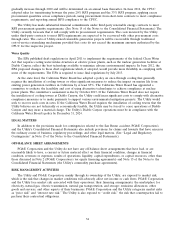PG&E 2012 Annual Report Download - page 39
Download and view the complete annual report
Please find page 39 of the 2012 PG&E annual report below. You can navigate through the pages in the report by either clicking on the pages listed below, or by using the keyword search tool below to find specific information within the annual report.The Utility actively manages market risk through risk management programs designed to support business
objectives, discourage unauthorized risk-taking, reduce commodity cost volatility, and manage cash flows. The Utility
uses derivative instruments only for non-trading purposes (i.e., risk mitigation) and not for speculative purposes. The
Utility’s risk management activities include the use of energy and financial instruments such as forward contracts,
futures, swaps, options, and other instruments and agreements, most of which are accounted for as derivative
instruments. Some contracts are accounted for as leases.
On July 21, 2010, President Obama signed into law federal financial reform legislation, the Dodd-Frank Wall
Street Reform and Consumer Protection Act (‘‘Dodd-Frank’’). PG&E Corporation and the Utility are implementing
programs to comply with the final regulations that have been issued pursuant to Dodd-Frank.
Commodity Price Risk
The Utility is exposed to commodity price risk as a result of its electricity and natural gas procurement activities,
including the procurement of natural gas and nuclear fuel necessary for electricity generation and natural gas
procurement for core customers. As long as the Utility can conclude that it is probable that its reasonably incurred
wholesale electricity procurement costs and natural gas costs are recoverable, fluctuations in electricity and natural
gas prices will not affect earnings. Such fluctuations, however, may impact cash flows. The Utility’s natural gas
transportation and storage costs for core customers are also fully recoverable through a ratemaking mechanism.
The Utility’s natural gas transportation and storage costs for non-core customers may not be fully recoverable.
The Utility is subject to price and volumetric risk for the portion of intrastate natural gas transportation and storage
capacity that has not been sold under long-term contracts providing for the recovery of all fixed costs through the
collection of fixed reservation charges. The Utility sells most of its capacity based on the volume of gas that the
Utility’s customers actually ship, which exposes the Utility to volumetric risk.
The Utility uses value-at-risk to measure its shareholders’ exposure to price and volumetric risks resulting from
variability in the price of, and demand for, natural gas transportation and storage services that could impact revenues
due to changes in market prices and customer demand. Value-at-risk measures this exposure over a rolling 12-month
forward period and assumes that the contract positions are held through expiration. This calculation is based on a
95% confidence level, which means that there is a 5% probability that the impact to revenues on a pre-tax basis,
over the rolling 12-month forward period, will be at least as large as the reported value-at-risk. Value-at-risk uses
market data to quantify the Utility’s price exposure. When market data is not available, the Utility uses historical
data or market proxies to extrapolate the required market data. Value-at-risk as a measure of portfolio risk has
several limitations, including, but not limited to, inadequate indication of the exposure to extreme price movements
and the use of historical data or market proxies that may not adequately capture portfolio risk.
The Utility’s value-at-risk calculated under the methodology described above was approximately $13 million and
$11 million at December 31, 2012 and 2011, respectively. During the 12 months ended December 31, 2012, the
Utility’s approximate high, low, and average values-at-risk were $13 million, $10 million and $12 million, respectively.
And during 2011, the value-at-risk amounts were $11 million, $7 million and $9 million, respectively. (See Note 10 of
the Notes to the Consolidated Financial Statements for further discussion of price risk management activities.)
Interest Rate Risk
Interest rate risk sensitivity analysis is used to measure interest rate risk by computing estimated changes in cash
flows as a result of assumed changes in market interest rates. At December 31, 2012 and December 31, 2011, if
interest rates changed by 1% for all current PG&E Corporation and Utility variable rate and short-term debt and
investments, the change would affect net income for the next 12 months by $7 million and $13 million, respectively,
based on net variable rate debt and other interest rate-sensitive instruments outstanding.
Energy Procurement Credit Risk
The Utility conducts business with counterparties mainly in the energy industry, including other California
investor-owned electric utilities, municipal utilities, energy trading companies, financial institutions, and oil and
natural gas production companies located in the United States and Canada. If a counterparty fails to perform on its
contractual obligation to deliver electricity or gas, then the Utility may find it necessary to procure electricity or gas
at current market prices, which may be higher than the contract prices.
The Utility manages credit risk associated with its counterparties by assigning credit limits based on evaluations
of their financial conditions, net worth, credit ratings, and other credit criteria as deemed appropriate. Credit limits
35
























